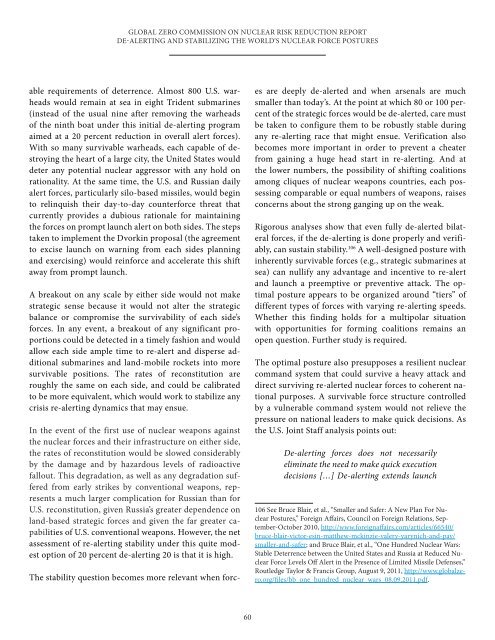global_zero_commission_on_nuclear_risk_reduction_report
global_zero_commission_on_nuclear_risk_reduction_report
global_zero_commission_on_nuclear_risk_reduction_report
Create successful ePaper yourself
Turn your PDF publications into a flip-book with our unique Google optimized e-Paper software.
GLOBAL ZERO COMMISSION ON NUCLEAR RISK REDUCTION REPORTDE-ALERTING AND STABILIZING THE WORLD’S NUCLEAR FORCE POSTURESable requirements of deterrence. Almost 800 U.S. warheadswould remain at sea in eight Trident submarines(instead of the usual nine after removing the warheadsof the ninth boat under this initial de-alerting programaimed at a 20 percent reducti<strong>on</strong> in overall alert forces).With so many survivable warheads, each capable of destroyingthe heart of a large city, the United States woulddeter any potential <strong>nuclear</strong> aggressor with any hold <strong>on</strong>rati<strong>on</strong>ality. At the same time, the U.S. and Russian dailyalert forces, particularly silo-based missiles, would beginto relinquish their day-to-day counterforce threat thatcurrently provides a dubious rati<strong>on</strong>ale for maintainingthe forces <strong>on</strong> prompt launch alert <strong>on</strong> both sides. The stepstaken to implement the Dvorkin proposal (the agreementto excise launch <strong>on</strong> warning from each sides planningand exercising) would reinforce and accelerate this shiftaway from prompt launch.A breakout <strong>on</strong> any scale by either side would not makestrategic sense because it would not alter the strategicbalance or compromise the survivability of each side’sforces. In any event, a breakout of any significant proporti<strong>on</strong>scould be detected in a timely fashi<strong>on</strong> and wouldallow each side ample time to re-alert and disperse additi<strong>on</strong>alsubmarines and land-mobile rockets into moresurvivable positi<strong>on</strong>s. The rates of rec<strong>on</strong>stituti<strong>on</strong> areroughly the same <strong>on</strong> each side, and could be calibratedto be more equivalent, which would work to stabilize anycrisis re-alerting dynamics that may ensue.In the event of the first use of <strong>nuclear</strong> weap<strong>on</strong>s againstthe <strong>nuclear</strong> forces and their infrastructure <strong>on</strong> either side,the rates of rec<strong>on</strong>stituti<strong>on</strong> would be slowed c<strong>on</strong>siderablyby the damage and by hazardous levels of radioactivefallout. This degradati<strong>on</strong>, as well as any degradati<strong>on</strong> sufferedfrom early strikes by c<strong>on</strong>venti<strong>on</strong>al weap<strong>on</strong>s, representsa much larger complicati<strong>on</strong> for Russian than forU.S. rec<strong>on</strong>stituti<strong>on</strong>, given Russia’s greater dependence <strong>on</strong>land-based strategic forces and given the far greater capabilitiesof U.S. c<strong>on</strong>venti<strong>on</strong>al weap<strong>on</strong>s. However, the netassessment of re-alerting stability under this quite modestopti<strong>on</strong> of 20 percent de-alerting 20 is that it is high.The stability questi<strong>on</strong> becomes more relevant when forcesare deeply de-alerted and when arsenals are muchsmaller than today’s. At the point at which 80 or 100 percentof the strategic forces would be de-alerted, care mustbe taken to c<strong>on</strong>figure them to be robustly stable duringany re-alerting race that might ensue. Verificati<strong>on</strong> alsobecomes more important in order to prevent a cheaterfrom gaining a huge head start in re-alerting. And atthe lower numbers, the possibility of shifting coaliti<strong>on</strong>sam<strong>on</strong>g cliques of <strong>nuclear</strong> weap<strong>on</strong>s countries, each possessingcomparable or equal numbers of weap<strong>on</strong>s, raisesc<strong>on</strong>cerns about the str<strong>on</strong>g ganging up <strong>on</strong> the weak.Rigorous analyses show that even fully de-alerted bilateralforces, if the de-alerting is d<strong>on</strong>e properly and verifiably,can sustain stability. 106 A well-designed posture withinherently survivable forces (e.g., strategic submarines atsea) can nullify any advantage and incentive to re-alertand launch a preemptive or preventive attack. The optimalposture appears to be organized around “tiers” ofdifferent types of forces with varying re-alerting speeds.Whether this finding holds for a multipolar situati<strong>on</strong>with opportunities for forming coaliti<strong>on</strong>s remains anopen questi<strong>on</strong>. Further study is required.The optimal posture also presupposes a resilient <strong>nuclear</strong>command system that could survive a heavy attack anddirect surviving re-alerted <strong>nuclear</strong> forces to coherent nati<strong>on</strong>alpurposes. A survivable force structure c<strong>on</strong>trolledby a vulnerable command system would not relieve thepressure <strong>on</strong> nati<strong>on</strong>al leaders to make quick decisi<strong>on</strong>s. Asthe U.S. Joint Staff analysis points out:De-alerting forces does not necessarilyeliminate the need to make quick executi<strong>on</strong>decisi<strong>on</strong>s […] De-alerting extends launch106 See Bruce Blair, et al., “Smaller and Safer: A New Plan For NuclearPostures,” Foreign Affairs, Council <strong>on</strong> Foreign Relati<strong>on</strong>s, September-October2010, http://www.foreignaffairs.com/articles/66540/bruce-blair-victor-esin-matthew-mckinzie-valery-yarynich-and-pav/smaller-and-safer; and Bruce Blair, et al., “One Hundred Nuclear Wars:Stable Deterrence between the United States and Russia at Reduced NuclearForce Levels Off Alert in the Presence of Limited Missile Defenses,”Routledge Taylor & Francis Group, August 9, 2011, http://www.<str<strong>on</strong>g>global</str<strong>on</strong>g><str<strong>on</strong>g>zero</str<strong>on</strong>g>.org/files/bb_<strong>on</strong>e_hundred_<strong>nuclear</strong>_wars_08.09.2011.pdf.60


